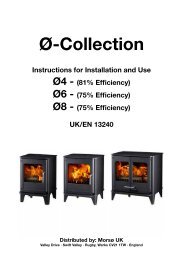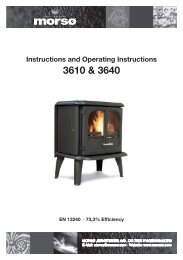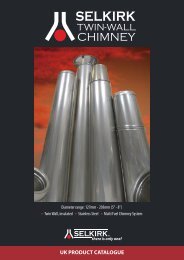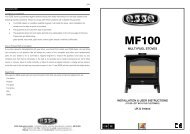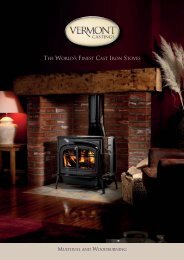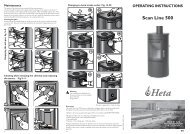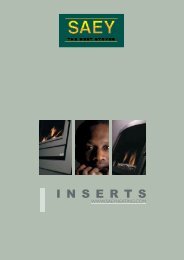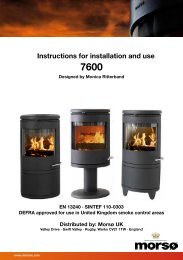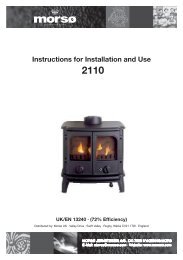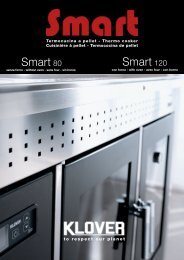Morsø 5660 - Stoves Online
Morsø 5660 - Stoves Online
Morsø 5660 - Stoves Online
Create successful ePaper yourself
Turn your PDF publications into a flip-book with our unique Google optimized e-Paper software.
<strong>Morsø</strong> <strong>5660</strong>DKUKOpstillings- og betjeningsvejledningInstructions for installation and usewww.morsoe.com
Indhold · ContentDK 1.0 Opstilling af Deres morsø ovn .. .. .. .. .. .. .. .. .. .. ..52.0 Fyringsteknik/Brugen af Deres ovn .. .. .. .. .. .. .. 143.0 Regelmæssig vedligeholdelse af ovnen . .. .. .. .. 174.0 Tekniske data .. .. .. .. .. .. .. .. .. .. .. .. .. .. .. .. .. .. .. 18UK 1.0 Installing your <strong>Morsø</strong> stove .. .. .. .. .. .. .. .. .. .. .. 212.0 Firing/using the stove. .. .. .. .. .. .. .. .. .. .. .. .. .. .. 303.0 Routine stove maintenance .. .. .. .. .. .. .. .. .. .. .. 334.0 HETAS admendments. .. .. .. .. .. .. .. .. .. .. .. .. .. .. 352
Opstillings- og betjeningsvejledning<strong>5660</strong>EN 13240 · SINTEF 110-261MORSØ JERNSTØBERI A/S . DK-7900 NYKØBING MORSE-Mail: stoves@morsoe.com · Website: www.morsoe.com3
Til lykke med Deres nye <strong>Morsø</strong> ovn!<strong>Morsø</strong>, som er den største udbyder på det danskemarked, har siden 1853 fremstillet brændeovneaf den højeste kvalitet. Hvis De blot følger omståendeinstruktioner, er vi sikre på, at De ogsåvil få nytte og glæde af Deres nye ovn i mange år.IndholdSide nr1.0 Opstilling af Deres morsø ovn 51.1 Udpakning af ovnen 51.2 Opstilling af ovnen 51.3 Skorstensfejer 51.4 Ovnens placering/Afstandskrav 51.5 Skorstenen 111.6 Tilslutning til muret skorsten 121.7 Tilslutning til stålskorsten 121.8 Trækforhold 132.0 Fyringsteknik 142.1 Optænding og fyringsintervaller 153.0 Regelmæssig vedligeholdelse af ovnen 173.1 Udvendig vedligeholdelse 173.2 Indvendig vedligeholdelse 173.3 Rensning af ovn 184.0 Tekniske Data 18Prøvningsattest - skal følge ovnenDen danske Brændeovnsbekendgørelse trådte ikraft den 1. januar 2008. I forbindelse medindførelsen af Brændeovnsbekendgørelsen er det et krav, at der med brændeovnen følger enprøvningsattest, der er udstedt af det akkrediterede prøvningsinstitut, der har udført miljøafprøvningenpå ovnen.Prøvningsattesten er vedlagt i ovnen og skal opbevares af ejeren og følge ovnen i ovnenslevetid.Efter installation af brændeovnen og godkendelse af en skorstensfejer skal skorstensfejerenunderskrive prøvningsattesten som dokumentation på, at ovnen opfylder miljøkravene i henholdtil Brændeovnsbekendgørelsen.Ekstra tilbehørTil <strong>Morsø</strong> ovnene tilbydes et omfattende skorstens-, gulvplade- og tilbehørsprogram, der kanlette den daglige betjening og vedligeholdelse af Deres <strong>Morsø</strong> ovn.StøbejernStøbejern er et levende materiale. Der er derfor ikke to ovne, der er helt ens. Det skyldes delstolerancerne på støbejern, dels at ovnene er håndværksmæssigt udført.4
1.0 Opstilling af Deres <strong>Morsø</strong> Ovn1.1 Udpakning af ovnenDet anbefales at være to mand til dette arbejde, da ovnen er tung at håndtere ene.MORSØ <strong>5660</strong> vejer ca. 125 kg.Ovnen er egnet til intermitterende brug.1.2 Opstilling af ovnenMan skal være opmærksom på nationale og lokale bestemmelser vedrørende opstilling afbrændeovne. Samtidig skal man følge de lokale bestemmelser med hensyn til tilslutning tilskorsten samt opstilling af skorstene. Spørg evt. Deres skorstensfejer til råds. Det er dog Demselv, Deres tekniske rådgiver eller håndværker, der er ansvarlig for, at de nationale og lokalebestemmelser overholdes.1.3 SkorstensfejerDet kan, som nævnt, være klogt at rådføre sig med den lokale skorstensfejer inden opstillingaf ovnen. Under alle omstændigheder skal skorstensfejeren underrettes, når brændeovnen eropstillet. Skorstensfejeren foretager et check af installationen, og der aftales fejningsterminer.Hvis skorstenen ikke har været i brug i nogen tid, bør den undersøges for revnedannelser, fuglerederm.v., inden den igen tages i brug.1.4 Ovnens placering/Afstandskrav.Kravene til indsatsovnens placering og afstandskrav er afhængig af i hvilket miljø indsatsenplacres iA. Som indbygning i murværk eller i eksisterende pejseåbningB. Specialbygget pejsemiljø i brændbare omgivelserA. Indbygning i murværk eller i eksisterende pejseåbningIndsatsovnen er hovedsagligt beregnet til indbygning i murværk eller i eksisterende pejseåbning.De tilstødende materialer skal være ubrændbare.Et lag tapet bliver normalt, når det er påsat murværk, betragtet som ikke-brændbart materiale.Et ikke brændbart underlag skal dække gulvet mindst 300 mm. foran fyrdøren, og mindst150 mm. til hver side foran fyråbningen.Vær opmærksom på at gulvet skal kunne bære installationen.Kun når ovnen placeres op ad brændbart materiale, stilles der krav til afstand.Der følgende afstandskrav.Møbleringsafstand1300 mm.*Afstand til 90° brændbar sidevæg 400 mm.Højde over brændbar gulv 300 mm.**5
400*300 **300150Date of print: 10-06-2010Material:Weight:Model no.Drawingtype:Location of file: U:\udv\Tegninger\5600\5600 Assembly.SLDASMThis drawing is <strong>Morsø</strong> Jernstøberi A/S' property and<strong>Morsø</strong> <strong>5660</strong> tilsluttet til eksisterende muretskorsten6of print: 11-06-2010A-AMaterial:Weight:Model no.Drawingtype:
MonteringEksisterende røgspjæld i skorsten fjernes eller låses i åben stillingDet er vigtigt, at der er nogle millimeter luft mellem pladekassen og det omgivende murværk, davarmeudvidelsen af pladekassen ellers kan forårsage revnedannelse i murværket.Som udgangspunkt kan man regne med en indfatningsåbning på 725 mm.x530 mm.x465mm.(bredde x højde x dybde) i murværket.Indsatsen skal rettes op ved hjælp af stilleskruerne, så indsatsen står vandret. Bemærk, atkassen skal være plan med murværket. Man kommer til stilleskruerne ved at løfte vermiculitebundpladen op.Det kan være en fordel at isolere omkring pladekassen med 25-50 mm Rockwool eller lignendevarmebestandigt isoleringsmateriale.Forbindelsen mellem indsatsen og skorstenen udføres med et ø 150 mm røgrør, som fastgøresi røgrørsstudsen med de medfølgende selvskærende skruer (forboring ø 3,00 mm) og tætnesmed den medfølgende tætningssnor.Mellem røgrøret og den murede skorsten tætnes med ildfast mørtel. En varmeudvidelse afrøgrøret kan forårsage revnedannelse i den ildfaste mørtel. Det er derfor vigtigt at bruge enmurbøsning og tætningssnor.Hvis der ikke i forvejen er en renselem som vist på skitserne, kan det være en fordel at montereen. Herved gøres monteringen af røgrøret lettere; men i nogle tilfælde kan det være et krav fraskorstensfejeren.Til <strong>Morsø</strong> <strong>5660</strong> ovnen skal der tilsluttesen 45° rørbøjning på denstøbte røgtud (1).Med rørbøjningen kan man opnåbåde vandret og lodret røgafgang,afhængig af, hvorledes man venderrørbøjningen under monteringenPlacering af røgledepladerRøgledepladerne (2) og (3), der erudført i vermiculite, er placeret vedmodtagelsen.Man skal sikre sig, at røgledepladerneer korrekt monteret inden enoptænding af ovnen finder sted.( se skitse )1 2 3AA7
300**B. Specialbygget pejsemiljø i brændbare omgivelserIsoleret stålskorstenVentilationsåbning500 cm²Ubrændbar plade400*Gasbetonsten150300Material:Weight:Ventilationsåbning 350 cm²Model no.Drawingtype:Location of file:U:\udv\Tegninger\5600\5600 Assembly.SLDASMThis drawing is <strong>Morsø</strong> Jernstøberi A/S' prope8
25Min. 850Min.100Date of print: 11-06-2010Material:Weight:Model noDrawingtLocation ofThis draw259
Såfremt indsatsovnen opstilles i brændbart miljø skal der bygges et pejsemiljø som indsatsenskal sættes ind i. Pejsemiljøet skal sikre beskyttelse af omgivelserne mod indsatsens varmepåvirkningved hjælp af afskærmning og ventilation. Der findes utallige individuelle måder atbygge et pejsemiljø på.Følgende er derfor en principiel vejledning.Pejsemiljøet, som skal huse indsatsen skal som minimum opbygges af gasbetonsten med enbredde på minimum 100 mm. Benyttes der andre ubrændbare materialer (mursten, rockwoolm.m.) skal man sikre sig at isoleringsgraden modsvares.Man skal sikre sig, at åbningen, hvor indsatsen sættes i, har den rigtige størrelse. I siderne skalder være 25 mm. imellem indsatsens pladekasse og pejsemiljøets væg. Imellem pladekassensbagvæg og pejsemiljøets bagvæg skal der være minimum 100 mm. Åbningen skal som minimumplaceres 300 mm. over gulv, hvis det er udført i brændbart materialePejsemiljøet skal have udluftningshuller.Indløbshullet skal som minimum have et areal på 350 cm², og skal placeres i niveau underindsatsen. Luften, der kommer igennem indløbshullet skal kunne passere op og forbi indsatsen.Udløbshullet skal som minimum have et areal på 500 cm², og skal placeres i niveau overindsatsen. Udløbshullet skal placeres minimum 850 mm. fra loft.Lige over udløbshullet skal en ubrændbar plade (25 mm. Rockwool el. tilsvarende) dækkehenover pejsemiljøetEt ikke brændbart underlag skal dække gulvet mindst 300 mm. foran fyrdøren, og mindst150 mm.til hver side foran fyråbningen.Vær opmærksom på at gulvet skal kunne bære installationen.Overholdes ovenstående retningslinjer er det tilladt at placere brændbart materiale op ad pejsemiljøetssider og bagvæg.Afstand til 90° brændbar væg foran fyråbningen: 400 mm.Møbleringsafstand:1300 mm.MonteringIndsatsen placeres i pejsemiljøets åbning og rettes op ved hjælp af stilleskruerne, så indsatsenstår vandret.Forbindelsen mellem indsatsen og skorstenen udføres med et ø 150 mm røgrør, som fastgørestil røgrørsstudsen med de medfølgende selvskærende skruer (forboring ø 3,00 mm) og tætnesmed den medfølgende tætningssnor.Røgen i skorsten kan blive høj. Derfor skal man sørge for at afstande til brændbart materialerbliver overholdt.10
MøbleringsafstandDen anbefalede møbleringsafstand er 1300 mm, men man bør dog vurdere, om møbler og andetvil blive udtørret af at stå tæt på ovnen.Afstand til brændbart materiale foran ovnen er 1300 mm.En brændeovn bliver varm under fyring. Der skal derfor udvises en fornøden forsigtighed, specielti.f.m. børns kontakt med ovnen.Ovnen er udstyret med et aftageligt håndtag i rustfrit stål - et materiale der leder varmen dårligt.Når håndtaget er fjernet, er ovnen samtidig mere børnesikker.1.5 SkorstenenHvis lokale bestemmelser tillader det, kan ovnen tilsluttes en skorsten, hvortil der i forvejen ertilsluttet et andet lukket ildsted ( f.eks. en anden brændeovn eller oliefyr ). Men bemærk at enbrændeovn ikke må tilsluttes samme skorsten som nye kondenserende oliefyr. Er De i tvivl bedesDe kontakte Deres skorstensfejer.Man skal være opmærksom på eventuelle krav til placering af røgrør, hvis to eller flere ildstedertilsluttes samme skorsten.Brændeovnen må aldrig tilsluttes en skorsten, hvor et gasfyr er tilsluttet.En moderne effektiv ovn stiller større krav til Deres skorsten. Lad derfor skorstensfejeren vurdereskorstenen.Skorstenens lysning skal følge de nationale og lokale bestemmelser. Men generelt bør lysningsarealetmindst være 175 cm 2 (150 mm diameter ) for brændeovne.En for stor skorstenslysning bevirker, at der bruges for meget energi på at få opvarmet skorstenentil et acceptabelt træk. Er der tale om en muret skorsten med større lysning, anbefales det atisætte en isolerende skorstensforing med den rigtige diameter. Herved opnås et forøget trækog tillige en bedre fyringsøkonomi.Der stilles ingen krav til nogen bestemt skorstenshøjde, men den skal være så høj, at trækforholdeneer i orden og røgen ikke generer. Som hovedregel er trækforholdene tilfredsstillende,når skorstenen er 4 meter over ovnen og er ført mindst 80 cm over tagrygningen. Placeresskorstenen ved husets sider bør toppen af skorstenen aldrig være lavere end husets tagryg ellertagets højeste punkt. Bemærk, at der ofte gælder nationale og lokale bestemmelser med hensyntil placering af skorstene i forbindelse med stråtag. Se afsnittet trækforhold 1.9.Skorsten og røgrør skal forsynes med renselemme. Størrelsen på renselemme i skorsten skalmindst svare til skorstenens lysningsareal.Skorstenen skal være tilgængelig for udvendigt eftersyn, og der skal være mulighed for adgangtil renselemme og til skorstenen, hvis den skal renses fra toppen (eks. stålskorstene).11
1.6 Tilslutning til muret skorstenI den murede skorsten fastmures en røgrørsbøsning, og røgrøret føres ind i denne. Røret må ikkestikkes ind i selve skorstensåbningen, men kun gå til den indvendige side af skorstenslysningen.Samlingerne ved ovn/rør og rør/murbøsning skal tætnes med den vedlagte glassnor. Normaltbehøver man ikke tætne mellem evt. rørsamlinger.Evt. overgang fra lodret til vandret røgrør kan med fordel monteres med en blød bøjning for atundgå tab af skorstenstræk.Dimensioneringen af røgrør skal følge de nationale og lokale bestemmelser. <strong>Morsø</strong> anbefalerdog, at røgrør udføres i 2 mm stålplade, da det vil forlænge røgrørets levetid.1.7 Tilslutning til stålskorstenEr der tale om opstilling, hvor skorstenen føres direkte op gennem loftet, skal man følge denationale og lokale bestemmelser m.h.t. skorstenens afstand til brandbart loft. Skorstenen tætnesved røgtuden med vedlagte glassnor. Det er vigtigt at skorstenen er monteret med tagbæring, sådet ikke er ovnen der bærer skorstenen. (Se skorstensfabrikantens vejledning). En stor vægt påovnens topplade kan forårsage revnedannelse af denne. <strong>Morsø</strong>s garanti omfatter ikke toppladen,hvis skorstenen er monteret uden tagbæring.Skulle der opstå skorstensbrand i.f.m. fejlbetjening af ovnen eller længere tids anvendelse affugtigt brændsel, lukkes spjældet helt, og brandvæsnet kontaktes.Vær opmærksom på!Rensningsmuligheder. Tal med skorstensfejeren.Undgå flere bøjninger end nødvendigt og begræns røgrørslængden, da trækforholdeneellers nedsættes.FrisklufttilførselEn brændeovn kræver luft til forbrændingen. Dette bevirker, at brændeovnsfyringer med til at give et sundt indeklima i et hus. Hvis huset er meget tæt, og isærhvis der er emhætte eller ventilationsanlæg i huset, kan det være nødvendigt atanbringe en luftrist i det rum, hvor brændeovnen er opstillet. I modsat fald vilskorstenstrækket blive for svagt, hvilket kan medføre at ovnen ikke vil brændeordentligt, og der kan komme røg ud af ovnen når fyrdøren åbnes.Er det nødvendigt at anbringe luftriste, skal de placeres således, at de ikke kanblokeres.12
1.8 TrækforholdHvis der kommer røg ud af ovnen, når fyrdøren åbnes, skyldes det dårligt skortstenstræk.Der kræves et skorstenstræk på mindst 12 pa. for at afgive tilfredsstillende forbrænding ogforhindre røgudslip. Der vil dog være risiko for røgudslip, hvis ovndøren åbnes under megetkraftig fyring.Røggastemperaturen ved nominel ydelse er 286°C henført til 20°C.Røggasmasseflowet er 7,1 gr./sek.Er De i tvivl, kan De eventuelt lade Deres skorstensfejer måle trækket i skorstenen.TrækforholdSkorstenens træk skabes på grund af forskellen mellem den høje temperatur iskorstenen og den koldere udetemperatur. Skorstenens længde og isolering, vindog vejrforhold er også afgørende for, at man kan opnå det rette undertryk, så trækketskabes.Nedsat træk fremkommer når:- temperaturforskellen er for lille. Eksempelvis ved for dårlig isoleret skorsten.Hvis skorstenen er kold, kan det inden optænding hjælpe at antænde (afblusse)en sammenkrøllet avis i skorstenens rensedør.- Udetemperaturen er for høj. Eksempelvis om sommeren.- Det er vindstille.Skorstenen ikke har den rette højde, så den er i læ af tagflade og høje træer.I disse tilfælde er der også størst risiko for røgnedslag.- Der kommer falsk luft ind i skorstenen. Eksempelvis gennem manglendefuger eller utætheder ved renselem eller røgrør.- Der er utætte ubenyttede ildsteder tilsluttet skorstenen.- Røgrør og skorsten er tilstoppet af sod p.g.a. manglende rensning.- Huset er for tæt (se afsnittet: Frisklufttilførsel).Godt træk fremkommer når:- Temperaturforskellen i skorstenen og udenfor er stor. Altså ved fyring, nårbehovet er størst.- Det er klart i vejret og der er en god vind.- Skorstenen har den rette højde. Min. 4 meter over ovnen og fri af tagryg.13
2.0 Fyringsteknik/Brugen af Deres ovnOvnens varmeafgivelse reguleres med reguleringshåndtaget under lågen.Ovnen har 3 typer forbrændingsluft.Sekundær forbrændingsluft der tilføres ned langs glasset. Denne luft reguleres af håndtagetunder lågen.Tertiær forbrændingsluft der tilføres forbrændingen lige over bålet. Denne lufttilførsel kan ikkereguleres.Pilot forbrændingsluft som sørger for at aktivere gløder og holde forbrændingen i gang, selvunder laveste spjæld indstilling. Denne lufttilførsel kommer fra to dyser på forrammen nederstbag lågen. Denne lufttilførsel kan ikke reguleres.Ovnens nominelle varmeydelse er 6,5 kW.Deres nye <strong>Morsø</strong> ovn er EN afprøvet og anbefalet til fyring med træ.VIGTIGT!Træ er et yderst gasholdigt materiale (ca. 75 %). Disse gasser frigives under opvarmningog antændelse af træet. Det er derfor vigtigt at disse gasser antændeshurtigt efter en påfyldning.Ligger træet kun og ulmer, specielt efter en ny påfyldning, giver det en kraftig røgudvikling,som i værste fald kan forårsage en eksplosionsagtig antændelse af gassernemed skader på ovnen til følge.For at kunne antænde disse frigivne gasser fra træet og opretholde klare og blivendeflammer i forbrændingsforløbet, er det derfor vigtigt altid at tilføre den nødvendigemængde ilt (luft)Indstilling af lufttilførsel, optændingsmetode og fyringsintervaller er afhængig afskorstenstræk, vind- og vejrforhold, varmebehov, brændsel m.m. Derfor kan der gåtid, inden De kender ovnens korrekte funktion under de givne forhold.Selv om der kan fyres med næsten alle former for træ i Deres <strong>Morsø</strong> ovn, bør manikke fyre med vådt eller ulagret træ. Træ bør under tag lagres mindst 1 år og helst 2år med fri adgang for vind. Træ skal kløves hurtigst muligt efter fældningen, hvis detskal tørre hurtigt.Brug aldrig drivtømmer, da det som regel er meget saltholdigt, og ødelægger dermedbåde ovnen og skorsten. Imprægneret og malet træ samt spånplader udsendergiftig røg og dampe og må derfor heller ikke anvendes som brænde.Bemærk, der må ikke anvendes flydende brændsel i ovnen.Brændestykker med en diameter større end 10 cm bør altid kløves.Brændestykkerne må ikke være længere, end de kan ligge plant over glødelagetmed luft til begge ender.Maximal brændelængde i ovnen er 50 cm.Maximal brændemængde for begge ovne er 3,5 kg i timenDe første optændinger skal være moderate, således at den varmebestandige malingkan hærdes, inden der fyres kraftigere. Malingen kan i hærdningsfasen udvikle røgog lugtgener under den første optænding, hvilket er ganske normalt. Sørg derfor forudluftning i denne periode.14
2.1 Optænding og fyringsintervallerUnder optænding er der behov for en stor luftmængde. Startes der op med en helt kold ovn,kan man med fordel lade døren stå på klem de første minutter.For at opbygge et isolerende askelag i bunden af ovnen, bør De ved første optænding afbrændeca. 3 kg tørt pindebrænde. Behold herefter altid ca. 1 cm aske i bunden af brændkammeret.1. Glødelaget dannes hurtigt ved optænding med 2-4optændingstabletter eller 7-10 sammenkrølledeavissider under ca. 3-4 kg tørt pindebrænde.2. Der åbnes helt for sekundærluften vhareguleringshåndtaget.3. Efter antænding af papiret/sprittabletterne lukkesfyrdøren på klem, så der er godt med træk ved enåbning på ca. 2 cm.4. Når man kan se (efter 5-10 min.), at skorstenener så varm, at der er træk igennem den, lukkesdøren helt. Hvis alle forudsætninger er opfyldt, vilder efter yderligere ca. 15-20 min. være dannetet pænt glødelag i brandkammeret.5. Normal påfyring bør ske, mens der endnu er glødertilbage. Fordel gløderne i bunden, dog flest forani ovnen.6. Der lægges 2-3 stykker brænde à ca. 0,7-1 kg og30-50 cm lange ind over gløderne i ét lag med enafstand på ca. 1 cm mellem træ-stykkerne. Bedsteforbrænding opnås hvis kævlernes længderetninger parallel med ovnens bagvæg.7. Når den sekundære lufttilførsel er åbnet på max.og døren lukkes, vil den friske træ mængde væreantændt på et par minutter.8. Herefter justeres den sekundære luftmængdened til den ønskede position, og den optimaleforbrænding vil fortsætte til grundglød.Under den nominelle afprøvning lå påfyldningsintervalletpå 60-70 minutter.9. En ny portion træ kan påfyres på samme mådesom angivet i pkt. 5 & 6.15
Normalt skal ovndøren altid åbnes roligt de første 2-3 centimeter, og man skal vente til trykketer udlignet inden døren åbnes helt. På denne måde undgås eventuelle røggener specielt iforbindelse med dårlige trækforhold. Åbn aldrig ovndøren under voldsom fyring.Når træet er brændt ud, er det omdannet til glødende trækul. Hvis der så forinden er dannet etgodt glødelag oven på et tilstrækkeligt lag aske, kan ovnen holde sig varm meget længe ikkemindst i kraft af støbejernets gode egenskaber.Evt. natoverfyring frarådes på det kraftigste. Det sviner milljøet og giver en ringeudnyttelse af brændet, da træets gasser med den lave temperatur ikke antændes.Istedet sætter det sig som sod (uforbrændte gasser) i skorstenen og i ovnen. Underekstreme forhold såsom dårligt skorstenstræk, stor mængde træ eller vådt trækan en eksplosionsagtig antændelse i værste fald forekomme.Ved fyring om sommeren, når behovet for varme er minimal, bliver forbrændingendårlig. Ovnen varmer for meget og man skruer ned for forbrændingen. Men huskaltid at sørge for at der er blivende flammer, så længe træet ikke er omdannettil trækul. Ønsker De at fyre svagere gøres dette ved at påfylde mindre mængdetræ.Hvis man fyrer med vådt brænde, vil en stor del af brændets varmeenergi medgåtil at fortrænge vandet fra brændet, uden at afgive varme til ovnen. Denne ufuldstændigeforbrænding medfører sodaflejring i ovn, rør og skorsten.Sammenligning træfyring og olie:Træart (vandindhold på 20%)Antal rummeter pr. 1000 l. olieEg 7,0Bøg 7,0Ask 7,2Ær 7,5Birk 8,0Elm 8,9Rødgran 10,4Ædelgran 10,916
3.0 Regelmæssig vedligeholdelse af ovnen3.1. Udvendig vedligeholdelseOvnens overflade er malet med en varmebestandig senotherm maling. Den holder sig pænest,hvis den blot støvsuges med et blødt mundstykke eller aftørres med en tør fnugfri klud.Den malede overflade kan med tiden, ved for kraftig fyring, få et gråligt skær; men ovnen kan letopfriskes med en <strong>Morsø</strong> spraymaling, der kan købes hos Deres lokale forhandler.Kan købes i spray eller dåse.3.2 Indvendig vedligeholdelseGlasVed korrekt fyring med træ afsættes der ingen, eller kun lidt sod, på det keramiske glas. Er derunder optændelsen sket soddannelse på glasset, vil soden brænde væk, når der fyres normalti ovnen. Bliver glasset sodet grundigt til ved fejlbetjening, kan det let fjernes med f.eks. <strong>Morsø</strong>Glasrens. Glasset skal være koldt, når denne rengøring finder sted. Man skal undgå at fyldeovnen med så lange stykker brænde, at det presser på glasset, når lågen lukkes.Årsager til sodet glas:- For vådt brænde.- For store stykker brænde/ukløvet træ.- For lav forbrændingstemperatur.Udskiftning af glasKeramisk glas kan ikke genanvendes, fordi det har en højere smeltetemperatur. Blandes keramiskglas med almindelig glas, ødelægges råvaren og genvindingsprocessen af glas kanstoppe. Sørg for at det ildfaste glas ikke havner som almindelig genbrug. Det er til stor hjælpfor miljøet.OBS: Skal afleveres som keramisk glas på en genbrugsstation.Indvendige støbejernsdele/og andre sliddeleVermiculite sten og andre dele, som er i direkte berøring med ild og glødende brændsel, ersliddele. De vil derfor være særlig udsat for gennembrænding. Ved korrekt brug vil disse deleholde i mange år; men ved for kraftig fyring vil en gennembrænding selvfølgelig fremskyndes.De nævnte dele kan let udskiftes.Hvis røgledepladen beskadiges og ikke skiftes i tide, vil toppladen herefter være udsat for såhøj temperatur, at den kan tage skade.Bemærk, at en uautoriseret ændring af konstruktionen ikke må foretages, og at de dele, derudskiftes skal være originale <strong>Morsø</strong> dele.Årsager til for hurtig slitage af indvendige dele- For kraftig fyring: Brug af for meget tørt træ (møbelaffaldstræ).- For meget sod ovenpå røgledepladen (se. afsnit Rensning).PakningerMed tiden vil pakningerne i lågen blive slidte og skal, for at undgå løbsk forbrænding, udskiftesefter behov. Brug det originale <strong>Morsø</strong> pakningssæt, der leveres med en nøje vejledning.Bemærk: Normale sliddele er ikke omfattet af <strong>Morsø</strong>s udvidede garantiordning.Vedligeholdelsessortiment (Reservedele, Glasrens, Maling, Pakningssæt m.m.) findes hos Deres<strong>Morsø</strong> forhandler.17
3.3 Rensning af ovnSpecielt over røgledepladen vil der, som følge af trækket i skorstenen og efter en fejning,komme et aske- og sodlag. Asken vil have en isolerende virkning, hvilket kan fremskyndegennembrænding af røgledepladen, da den ikke kan komme af med varmen. Under normalrensning kan røgledepladen tages ud af ovnen. I dag skal skorstensfejeren, udover fejning afskorsten og rensning af røgrør, sørge for tømning af sod i ovnen.Antallet af årlige fejninger/rensning af ovn vurderes af skorstensfejeren efter samråd medDem.AskeSom tidligere beskrevet bør der være ca. 1 cm isolerende askelag i bunden af brandkammeret,for at opnå en høj forbrændingstemperatur. Når askelaget er for tykt, fjernes den overskydendedel.Asken må i de fleste tilfælde bortskaffes med dagrenovationen. Da der kan ligge gløder gemt iaskeskuffen i flere døgn, kan det være nødvendigt at opbevare asken i en beholder af ubrændbartmateriale, inden asken hældes i affaldssækken.Aske fra en brændeovn kan ikke gavne haven som gødning. Hvis der har været afbrændtfarvelagte brochurer, malet eller imprægneret træ og lignende i ovnen, må asken ikke hældesud på jord, da den kan indeholde tungmetaller.Vedligeholdelsesdele til <strong>5660</strong>BeskrivelseProduktnr.Sten, bag 79560200Sten, side 79560300Sten, bund front 79561600Sten, bund bag 79561700Røgledeplade, øverst 79560700Røgledeplade, nederst 795611004.0 Tekniske DataOvn model <strong>Morsø</strong> <strong>5660</strong>CO emission (ved 13 % O2) (%) 0.10OGC (tjære o.l.) emission (mg/m³) 96Partikel emission, vægtet gennemsnit (g/kg) 3,9Partikel emission, maks. i enkel prøvning (g/kg) 5,2Virkningsgrad (%) 75Nominel drifteffekt (kW) 6,6Røgtræk, minimum (Pa.) 12BrændselTræ18Alle måledata i henhold til prøvestandarder EN 13 240 samt NS 3058-3059.Prøvninger er foretaget hos akkrediteret prøvningsinstitut.
Instructions for Installation and Use<strong>5660</strong>EN 13240MORSØ JERNSTØBERI A/S . DK-7900 NYKØBING MORSE-Mail: stoves@morsoe.com · Website: www.morsoe.com
Enjoy your new <strong>Morsø</strong> stove!<strong>Morsø</strong>, the biggest stove company in the Danishmarket, has been making wood-burning stovesof the highest quality since 1853. Just follow theinstructions below, and we are certain that youwill be able to use and enjoy your new stove formany years.ContentsPage no1.0 Installing your <strong>Morsø</strong> stove 211.1 Unpacking the stove 211.2 Installing the stove 211.3 Chimney sweep 211.4 Location of the stove/distance requirements 211.5 The chimney 271.6 Connecting to a brick chimney 281.7 Connecting to a steel chimney 281.8 Draught 292.0 Firing/using the stove 302.1 Lighting instructions and fuelling intervals 313.0 Routine stove maintenance 333.1 External maintenance 333.2 Internal maintenance 333.3 Cleaning the stove 344.0 HETAS amendments 35Additional accessoriesWe offer a comprehensive line of chimney, floor plate and accessory products that canfacilitate the daily operation and maintenance of your <strong>Morsø</strong> stove.Cast ironCast iron is a live material. There are no two ovens that are identical. This is partly due to thetolerances of the casting process, partly because the ovens are a work of craftsmanship.20
1.0 Installing your <strong>Morsø</strong> stove1.1 Unpacking the stoveWe recommend that two persons perform this task since the stove is too heavy to handle single-handedly.MORSØ <strong>5660</strong> weighs approximately 125 kg.The stove is suited for intermittent use.1.2 Installing the stoveNational and local regulations regarding the installation of wood-burning stoves must beobserved, as must local regulations regarding chimney connections and chimney installation.You may want to ask your chimney sweep for advice. However, you, your technical adviser orworkman are responsible for complying with the applicable national and local regulations.1.3 Chimney sweepAs stated, it may be wise to consult your local chimney sweep before installing the stove.In any event, the chimney sweep must be notified once the wood-burning stove has beeninstalled. The chimney sweep will inspect the installation and schedule sweeping intervalswith you. If your chimney has not been used for some time, it should be inspected for cracks,bird nests, etc., before it is used.1.4 Location of the stove/distance requirementsThe requirements to the placement of the stove and the separation requirements depend onthe environment in which the stove is placed:A. Built into masonry or an existing fireplace openingB. Custom-built fireplace structure in flammable surroundingsA. Built into masonry or an existing fireplace openingThe insert is primarily designed to be built into masonry or an existing fireplace opening.The adjacent materials must be nonflammable.A layer of wallpaper is normally considered nonflammable when applied to masonry.A nonflammable floor protection must cover the floor at least 300 mm to the front of the firingdoor and at least 150 mm to each side of the firing opening.Please note that the floor must be capable of supporting the installation.There are only spacing requirements when the stove is placed next to flammable materials.The spacing requirements are the following:Distance to furniture1300 mm.*Right-angled distance to flammable sidewall 400 mm.Height over flammable floor 300 mm.**21
400*300 **300150Date of print: 10-06-2010Material:Weight:Model no.Drawingtype:Location of file: U:\udv\Tegninger\5600\5600 Assembly.SLDASMThis drawing is <strong>Morsø</strong> Jernstøberi A/S' property and<strong>Morsø</strong> 5600 connected to existing masonrychimney22of print: 11-06-2010A-AMaterial:Weight:Model no.Drawingtype:
MountingRemove or fix any existing damper in the chimney in the open position.It is important that there are a few millimetres between the insert box and the surrounding masonry.Otherwise, the thermal expansion of the insert box may cause cracking of the masonry.As an initial estimate, the dimensions of the insert opening in the masonry are 725 mm x 525mm x 445 mm (width x height x depth).The insert must be levelled with the levelling screws. Note that the insert box must be even (flush)with the masonry. You find the set screws by lifting up the vermiculite base plate.It may be advantageous to insulate with 25-50 mm Rockwool or similar heat-resistant materialaround the insert box.The insert is connected to the chimney by a 150 mm in diameter flue pipe that is fastened tothe flue collar with the supplied self-drilling screws (pre-drill to diameter 3.00 mm) and sealedwith the sealing cord supplied.Seal between the flue pipe and the masonry chimney with refractory mortar. A thermal expansionof the flue pipe may cause cracking of the refractory mortar. Therefore, it is important to use awall bushing and sealing cord.If there is no cleaning door as shown in the drawings, it may be advantageous to install one.This will make the installation of the flue pipe easier, and in some cases, the chimney sweepmay require one.For the <strong>Morsø</strong> <strong>5660</strong> stove, you willneed to connect a 45 degree pipebend to the cast-iron flue pipe(1). With the pipe bend, you canachieve both horizontal and verticalsmoke outlet, depending on whichway you turn the pipe bend whenyou fit it.Positioning of bafflesThe baffles (2) and (3), made fromvermiculite, have been positionedwhen you receive the stove.However, it is necessary that youcheck that they are correctly positionedbefore you light your stovefor the first time (please refer to thediagram).1 2 3AA23
300**B. Custom-built fireplace structure in flammable surroundingsInsulated steelchimneyV e n t i l a t i o nhole, 500 cm²Nonflammablesheet/slab400*Cellular concretemin. 100 mm150300Material:Weight:Ventilation hole, 350 cm²Model no.Drawingtype:Location of file:U:\udv\Tegninger\5600\5600 Assembly.SLDASMThis drawing is <strong>Morsø</strong> Jernstøberi A/S' prope24
25Min. 850Min.100Date of print: 11-06-2010MateriWeighModelDrawinLocationThis dra2525
If the insert is installed in a flammable environment, a fireplace structure must be built wherethe insert may be mounted. The fireplace structure will protect the surroundings against theheat effects of the insert through shielding and ventilation. There are numerous ways to builda fireplace structure.Therefore, the following is a guideline as to the principles.As a minimum, the fireplace structure to hold the insert must be constructed in cellular concretewith a minimum width of 100 mm. If other nonflammable materials (bricks, Rockwool,etc.) are used, ensure that the level of insulation is equivalent.Ensure that the opening for the insert has the right dimensions. To the sides, there must be 25mm between the insert box and the wall of the fireplace structure. There must be at least 100mm between the back panel of the insert box and the rear wall of the fireplace structure. If thefloor is made of a flammable material, the opening must be at least 300 mm over the floor.The fireplace structure must have ventilation holes.An entry hole with a surface of at least 350 cm2 must be placed at a level under the insert.The air that enters through the entry hole must be able to flow freely up past the insert. Anexit hole with a surface of at least 500 cm2 must be placed at a level above the insert. Theexit hole must be at least 850 mm from the ceiling.Right above the exit hole, a nonflammable sheet or slab (25 mm Rockwool or similar) mustcover the fireplace structure.A nonflammable floor protection must cover the floor at least 300 mm to the front of the firingdoor and at least 150 mm to each side of the firing opening.Please note that the floor must be capable of supporting the installation.If the guidelines above are observed, it is permissible to place flammable materials along thesides and back of the fireplace structure.Right-angled distance to flammable wall in front of the firing door:Distance to furniture:400 mm1300 mmMountingThe insert is positioned in the opening of the fireplace structure and levelled by means of thelevelling screws.The insert is connected to the chimney by a 150 mm diameter flue pipe that is fastened to theflue collar with the supplied self-drilling screws (pre-drill to diameter 3.00) and sealed with thesealing cord supplied.The smoke in the chimney gets hot. Therefore, ensure that the distances to flammable materialsare observed.26
Distance to furnitureWe recommend that the stove be installed 1300 mm from furniture, but consideration shouldalso be given to whether furniture, etc., will dry out as a result of its proximity to the stove.The distance to flammable material in front of the stove is 1300 mm.A wood-burning stove gets hot when it is fired. Caution must therefore be observed,particularly with regard to children touching the stove.The stove is equipped with a detachable handle in stainless steel – a poor heat conductor.When the handle is removed, the stove is more childproof at the same time.1.5 The chimneyIf local regulations permit, the stove may be connected to a chimney already serving anotherfireplace (such as an oil-burning stove or another wood-burning stove). Attention should bepaid to any requirements concerning the location of flue pipes if two or more fireplaces areconnected to the same chimney.The wood-burning stove must never be connected to a chimney to which a gas-burning stoveis already connected. An efficient, modern stove places great demands on the chimney, sohave a chimney sweep check the condition of your chimney.The aperture of the chimney must comply with national and local regulations. In general, theaperture area should measure at least 175 cm 2 (150 mm diameter) for wood-burning stoves.An overly large chimney aperture will mean that too much energy will be required to heat thechimney sufficiently to achieve an acceptable draught. If you have a brick chimney with alarge aperture, we recommend that you install an insulating chimney liner of the proper diameter.This will increase the draught, and improve the fuel economy.There are no requirements with respect to specific chimney heights, but a chimney must betall enough to provide a good draught, and to ensure that the smoke does not cause anyproblems. As a general rule, there will be a satisfactory draught if the chimney extends 4metres above the stove and at least 80 cm above the spine of the roof. If the chimney islocated along the side of the house, the top of the chimney should never be lower than thespine of the roof or the highest point on the roof. Please note that there are often national andlocal regulations regulating the location of chimneys in houses with thatched roofs. Pleasesee section 1.9 Draught.The chimney and the flue pipe must be fitted with cleaning doors, which must be at least thesame size as the chimney’s aperture area.The chimney must be accessible for external inspection, and it must be possible to accessthe cleaning doors and the chimney if it is to be cleaned from the top (e.g. steel chimneys).27
1.6 Connecting to a brick chimneyBrick a flue bushing securely into the wall, and insert the flue pipe into it. The pipe must notextend into the actual chimney opening, but only to the inside of the chimney aperture. Thejoints between the stove/pipe and pipe/wall bushing must be sealed with the glass tape provided.It is not normally necessary to seal between any pipe joints.If the flue pipe transitions from horizontal to vertical, it is a good idea to install it with a gentlebend so as to avoid any loss of draught.The flue pipe must be dimensioned in accordance with national and local regulations. <strong>Morsø</strong>recommends, however, that flue pipes be made of 2 mm sheet steel as this will extend theservice life.1.7 Connecting to a steel chimneyIf your installation involves routing the chimney straight up through the ceiling, it must complywith national and local regulations concerning the distance of the chimney from flammableceiling material. The chimney must be sealed at the smoke outlet using the glass tape provided.It is important to install the chimney with a roof support so that the stove does not bearthe weight of the chimney. (See the chimney manufacturer’s instructions). Heavy weights onthe stove’s top plate may cause it to crack. The <strong>Morsø</strong> warranty does not cover the top plateif the chimney is installed without a roof support.If a chimney fire should occur as a result of incorrect operation of the stove or prolonged useof wet fuel, close the vents completely and contact the fire brigade.Be aware of the following:Discuss the cleaning options with your chimney sweep.If there is insufficient draught in the chimney, it may be a good idea to installthe flue pipe straight up so as to minimise smoke migration in the actualcombustion chamber.Avoid having more bends than necessary, and limit the length of the flue pipeso as not to reduce the draught.Fresh air supplyA wood-burning stove requires air for combustion. As a result, firing awood-burning stove will help create a healthy climate in your house. If thehouse is very tightly sealed, and particularly if there is a cooker hood orventilation system in the house, it may be necessary to install an air grate in theroom in which the wood-burning stove is installed. Otherwise there may not beenough draught in the chimney, which may result in the stove not being ableto burn properly, and smoke may come out of the stove when the fire door isopened.If it is necessary to install air grates, they must be positioned so that they cannotbe obstructed.28
1.8 DraughtIf smoke comes out of the stove when the fire door is opened, it will be due to the poordraught in the chimney. This type of stove requires at least 12 PA of chimney draught toachieve satisfactory combustion and to prevent smoke from escaping. Smoke may, however,escape in any event if the stove door is opened during vigorous firing, so this should beavoided.The flue gas temperature at the rated output is 286°C relative to 20°C.The flue gas mass flow is 7.1 grammes/second.If in doubt, you may want to get your chimney sweep to measure the draught in the chimney.DraughtThe draught in the chimney is the result of the difference between the hightemperature in the chimney and the cooler temperature outside. Other factors thatdetermine whether sufficient negative pressure can be produced to create adraught include the length and insulation of the chimney, and wind and weatherconditions.The draught will be reduced when:- The temperature difference is too low, e.g. in connection with a poorly insulatedchimney.If the chimney is cold, it may help to light (burn up) a rolled-up newspaper in thechimney’s cleaning door.- The outside temperature is too high, e.g. during the summer.- There is no wind.- The chimney is not tall enough, with the result that it sits in the lee of the roofsurface or tall trees.These conditions are also associated with the greatest risk of smoke comingback down the chimney.- Air is entering the chimney in undesired places, e.g. through cracked joints orleaks in the cleaning door or the flue pipe.- Unsealed, unused fireplaces are connected to the chimney.- The flue pipe and chimney are clogged up with soot due to inadequatecleaning.- The house is too tightly sealed (please see the section on Fresh air supply).A good draught is 2achieved when:- There is a big difference between the temperature in the chimney and outside,i.e. when the need for heating is greatest.- The weather is clear and there is a good wind.- The chimney is of the proper height, i.e. Minimum 4 metres above the stove, andclear of the spine of the roof.29
2.0 Firing/using the stoveThe heat emission of the stove is regulated with the regulation lever under the door.The stove uses three types of combustion air.The secondary combustion air is supplied down along the glass. This air is regulated with thelever under the door.The tertiary combustion air is supplied to the combustion right over the fire. This air supplymay not be regulated.The pilot combustion air provides for the activation of embers and keeps the combustion goingeven at the lowest damper position. This air supply comes from two nozzles on the frontframe below the door. This air supply may not be regulated.The nominal heat output of the stove is 6.5 kW.Your NB! new <strong>Morsø</strong> stove is EN tested and recommended for burning wood.Wood is a material that contains a great deal of gas (approx. 75%). The gases are releasedwhen the wood is lit and heated. For this reason, it is important that these gasesare ignited quickly after stoking. If the wood just lies smouldering, especially afterre-stoking, a lot of smoke is created which, in the worst case, may cause an explosiveignition of the gases, resulting in damage to the stove.In order to ignite the gases that are released from the wood, and to keep clear, lastingflames during the combustion process, it is important to let in the required quantity ofoxygen (air supply) at all times. The setting of the air supply, the method of ignition andthe lighting intervals depend on the draught in the chimney, the wind and weather, theamount of heat required, the fuel, etc. This means that it may take some time beforeyou get to know the correct functioning of the stove under any given circumstances.Although you can fire your <strong>Morsø</strong> stove with almost all kinds of wood, you should notfire with wet wood, or unseasoned wood. Wood ought to be stored under a roof for atleast 1 year, and preferably 2 years, with free access to wind. Wood should be choppedas soon as possible after felling if it is to dry quickly. The wood can be used oncethe moisture is less than 20%. During the EN test, all stoves are tested with wood witha moisture content of (16 ± 4)%.Never use driftwood as it usually has a high salt content, which damages both the stoveand the chimney. Impregnated and painted wood and chipboard emit poisonoussmoke and fumes so they should not be used as fuel eitherPlease note that liquid fuel may not be used in the stove.Pieces of wood with a diameter exceeding 10 cm should always be chopped.The pieces of wood should be short enough to be able to lie flat over the layers ofembers, with air at both ends. The maximum length of fuel in the stove is 50 cm. Themaximum quantity of fuel is approx. 3,5 kg/hour.The first few times you light the stove, the fire should be moderate so that the heatresistantpaint can harden before firing more vigorously. During the hardening phase,the paint may develop obnoxious smoke and smell the first time it is lit, which is verynormal. Make sure that the room is well ventilated during this period.30
2.1 Lighting instructions and fuelling intervalsA lot of air is needed when lighting the stove. If you are starting with a cold stove, the doorshould be left ajar for the first few minutes. In order to build up an insulating layer of ash inthe bottom of the stove, you should burn 3 kg of dry kindling when you light the stove the firsttime.Always keep approx. 1 cm ash in the bottom of the combustion chamber.1. A layer of embers will form rapidly if the stove is lit with2-4 fuel tablets or 7-10 rolled-up sheets of newspaperunderneath approx. 3-4 kg dry kindling.2. Open up completely for the secondary air supply by meansof the regulation lever.3. After the paper/solid alcohol tablets have caught fire, leavethe fire door ajar about 2 cm so that the chimney drawswell.4. When you can see that the chimney is hot enough to draw(after 5-10 minutes), close the door. If all the necessaryconditions are met, a thick layer of embers will have beenformed in the combustion chamber after another 15-20 minutes.5. Re-stoking should normally be carried out while embersstill remain. Distribute the embers in the bottom, ensuringthat most of them are at the front of the stove.6. Place 2-3 logs of firewood, each weighing approximately0.7-1 kg and 30-50 cm long, over the embers in one layerseparated by approximately 1 cm. The best combustionis obtained if the longitudinal dimension of the logs isparallel with the rear wall of the stove.7. When the secondary air supply is opened to maximum andthe door is closed, the new quantity of wood will ignite ina few minutes.8. Subsequently, the secondary air supply is adjusted to thedesired level, and the optimum combustion will continueuntil only embers are left.Under the nominal test, the refill interval was 60-70 minutes.9. A new portion of wood can be added by repeating steps5 & 6.31
The stove door should normally be opened gently the first 2-3 cm, then you should wait untilthe pressure has equalised before opening the door all the way. This technique will preventsmoke from getting out, particularly when there is a poor draugt.The stove door should never be opened when the stove is being fired vigorously.Once the wood has burned out, it becomes glowing charcoall. If a good layer of embers hasalready formed on top of a sufficient layer of ash, the stove can keep warm for a very longtime, not least due to the favourable qualities of the cast iron.We would strongly recommend that you do not leave your stove alit at night.It harms the environment and constitutes very poor use of the wood as thegases in the wood do not ignite at the low temperature, but settle as soot(unburned gases) in the chimney and stove. Extreme conditions, such aspoor draught in the chimney, large quantities of wood or wet wood, may inthe worst-case scenario cause an explosive ignition.When firing in the summer period, when there is minimal need for heat, thecombustion will be poor. The stove provides too much heat so the combustionshould be reduced. But always remember to make sure that there arelasting flames until the wood becomes charcoal. If you want a weaker fire,stoke up using less wood.If you fire the stove using wet wood, a lot of the fuel’s thermal energy will bespent forcing the water out of the wood, without releasing any heat to thestove. This incomplete combustion results in a layer of soot being left in thestove, pipe and chimney.Comparison between firing with wood and oil:Type of wood (moisture content 20%)No. of cubic metres per 1000 l oilOak 7.0Beech 7.0Ash 7.2Sycamore 7.5Birch 8.0Elm 8.9Common spruce 10.4Silver fir 10.932
3.0 Routine stove maintenance3.1 External maintenanceThe cast surface of the stove is painted with heat-resistant Senotherm paint. It is bestmaintained by simply vacuuming it with a soft brush attachment or wiping it down with a dry,dust-free cloth.If the stove is used too vigorously, the painted surface may assume a greyish tinge over time,but the stove can easily be freshened up with <strong>Morsø</strong> spray paint, which is available from yourlocal retailer.<strong>Morsø</strong> stoves are painted in <strong>Morsø</strong> charcoal or <strong>Morsø</strong> light grey. The paint is available eitheras a spray or in tins.3.2 Internal maintenanceGlass windowIf the stove is used correctly, very little or no soot will be deposited on the ceramic glasswindow. If soot does form on the glass as the stove is being lit, it will burn away once normalcombustion begins in the stove. If the glass window becomes thoroughly covered in soot dueto incorrect operation, the soot can be easily removed using a cleaning agent such as <strong>Morsø</strong>Glass Cleaner. The glass must be cold when you clean it. Avoid stoking the stove with piecesof wood that are so long that they press against the glass window when the door is closed.Reasons for sooty glass window:- The fuel is too wet.- The pieces of fuel are to big/uncut wood.- The combustion temperature is too low.Ceramic glass replacementCeramic glass cannot be recycled because it has a higher melting point that ordinary glass.If ceramic glass is mixed with ordinary glass, the raw material is spoiled, and the reclaimingprocess may be halted. Take care that the ovenproof glass does not end up among ordinaryrecycled waste. That will be a great benefit to the environment.Note: Should be handed in to a recycling station as ceramic glass.Interior cast iron parts and other wear and tear partsVermiculite stones and other parts that are in direct contact with fire and burning fuel arewear and tear parts. As such, they are particularly exposed to being burnt through. Used correctly,these parts will last many years; but firing too heavily will of course accelerate burningthrough.The parts mentioned may easily be changed.If the baffle plate is damaged and not replaced in time, the top plate will be exposed to suchhigh temperatures that it may be damaged.Note that unauthorized changes of the construction may not be made, and parts mayonly be replaced with original <strong>Morsø</strong> parts.33
Reasons for overly rapid wear of internal parts- Stove fired too vigorously- Use of very dry wood (wood from old furniture).- Too much soot on top of the baffles (please see the section on Cleaning).- Too much ash in the ash pan (please see the section on Ash).GasketsWith time, the gaskets in the door will wear, and, in order to avoid wild combustion, theymust be replaced as required. Use an original <strong>Morsø</strong> gasket kit that is supplied with preciseinstructions for use.Note: Normal wearing parts are not covered by <strong>Morsø</strong>’s extended warranty.A selection of maintenance products (spare parts, glass cleaner, paint, gasket kit, etc.) isavailable from your <strong>Morsø</strong> dealer.3.3 Cleaning the stoveAshes and soot will settle, especially over the baffle plate, because of the draft in the chimneyand after a sweeping. The ashes have an insulating effect that may accelerate the burningthrough of the baffle plate because it cannot give off the heat. The baffle plate may be takenout of the stove during normal cleaning. Today, the chimney sweep, in addition to sweepingthe chimney and cleaning the flue pipes, must take care of removing soot from the stove.The chimney sweep will establish the annual number of sweeps and cleanings after havingconsulted you.AshAs noted above, there should be a layer of approximately 1 cm insulating ash in the bottomof the combustion chamber in order to achieve a high combustion temperature. If the layer ofash is too thick, it can be brushed down with an ash shovel, dustpan or similar tool.In most cases, the ash will need to be taken away by the waste disposal company. Becauseembers may be concealed in the ash pan for several days, it may be necessary to store theash in a container made of non-flammable material before pouring it into a rubbish bag.Ash from a wood-burning stove will not be of any benefit to your garden as fertiliser. If youhave burned colour brochures, or painted or treated wood, etc., in the stove, the resulting ashmust not be poured onto soil as it may contain heavy metals.Spare parts for the <strong>5660</strong>34DescriptionProduct no.Stone, rear 79560200Stone, side 79560300Stone, bottom front 79561600Stone, bottom rear 79561700Baffle plate, top 79560700Baffle plate, bottom 79561100
4.0 HETAS amendmentsHealth and safety precautionsSpecial care must be taken when installing the stove such that the requirements of the Healthand Safety at Work Act are met.HandlingAdequate facilities must be available for loading, unloading and site handling.Fire CementSome types of fire cement are caustic and should not be allowed to come into contact withthe skin. In case of contact wash immediately with plenty of water.AsbestosThis stove contains no asbestos. If there is a possibility of disturbing any asbestos in thecourse of installation then please seek specialist guidance and use appropriate protectiveequipment.Metal PartsWhen installing or servicing this stove care should be taken to avoid the possibility of personalinjury.Note of references to the current UK regulationsIn all cases the installation must comply with current Building Regulations, Local AuthorityByelaws and other specifications or regulations as they affect the installation of the stove.It should be noted that the Building Regulations requirements may be met by adopting therelevant recommendations given in British Standards BS 8303, BS EN 15287-1:2007 as analternative means to achieve an equivalent level of performance to that obtained following theguidance given in Approved Document J.Please note that it is a legal requirement under England and Wales Building Regulations thatthe installation of the stove is either carried out under Local Authority Building Control approvalor is installed by a Competent Person registered with a Government approved CompetentPersons Scheme. HETAS Ltd operate such a Scheme and a listing of their Registered CompetentPersons can be found on their website at www.hetas.co.uk.This stove must not be installed into a chimney that serves any other heating appliance.More detailed advice about existing chimney usageNOTE: A chimney height of not less than 4.5 metres measured vertically from the outlet of thestove to the top of the chimney should be satisfactory. Alternatively the calculation proceduregiven in EN 13384-1 may be used as the basis for deciding whether a particular chimney designwill provide sufficient draught.The outlet from the chimney should be above the roof of the building in accordance with theprovisions of Building Regulations Approved Document J.If installation is into an existing chimney then it must be sound and have no cracks or otherfaults which might allow fumes into the house. Older properties, especially, may have chimneyfaults or the cross section may be too large i.e. more than 230 mm x 230 mm. Remedialaction should be taken, if required, seeking expert advice, if necessary. If it is found neces35
sary to line the chimney then a flue liner suitable for solid fuel must be used in accordancewith Building Regulations Approved Document J.Any existing chimney must be clear of obstruction and have been swept clean immediatelybefore installation of the stove. If the stove is fitted in place of an open fire then the chimneyshould be swept one month after installation to clear any soot falls which may have occurreddue to the difference in combustion between the stove and the open fire.If there is no existing chimney then any new system must be to the designation describedabove and in accordance with Building Regulations Approved Document J.A single wall metal fluepipe is suitable for connecting the stove to the chimney but is notsuitable for use as the complete chimney. The chimney and connecting fluepipe must have aminimum diameter of 150 mm and its dimension should be not less than the size of the outletsocket of the stove.Any bend in the chimney or connecting fluepipe should not exceed 45°. 90° bends shouldnot be used.Combustible material should not be located where the heat dissipating through the walls offireplaces or flues could ignite it. Therefore when installing the stove in the presence of combustiblematerials due account must be taken of the guidance on the separation of combustiblematerial given in Building Regulations Approved Document J and also in these stoveinstructions.If it is found that there is excessive draught in the chimney then a draught stabiliser shouldbe fitted. Fitting of a draught stabiliser will affect the requirement for the permanent air supplyinto the room in which the stove is fitted in accordance with Approved Document J (see alsocombustion air supply).Commissioning and handoverEnsure all parts are fitted in accordance with the instructions.On completion of the installation allow a suitable period of time for any fire cement and mortarto dry out, before lighting the stove. Once the stove is under fire check all seals for soundnessand check that the flue is functioning correctly and that all products of combustion arevented safely to atmosphere via the chimney terminal.On completion of the installation and commissioning ensure that the operating instructionsfor the stove are left with the customer. Ensure to advise the customer on the correct use ofthe appliance and warn them to use only the recommended fuel for the stove.Advise the user what to do should smoke or fumes be emitted from the stove. The customershould be warned to use a fireguard to BS 8423:2002 (Replaces BS 6539) in the presence ofchildren, aged and/or infirm persons.Warning note on fume emissionProperly installed, operated and maintained this appliance will not emit fumes into the dwelling.Occasional fumes from de-ashing and re-fuelling may occur. However, persistent fumeemission is potentially dangerous and must not be tolerated. If fume emission does persist,the following immediate actions should be taken:-36
a) Open doors and windows to ventilate room.b) Let the fire out or eject and safely dispose of fuel from the appliance.c) Check for flue or chimney blockage, and clean if required.Do not attempt to relight the fire until the cause of the fume emission has been identified andcorrected. If necessary seek expert advice.Extractor fanThere must not be an extractor fan fitted in the same room as the stove as this can cause thestove to emit smoke and fumes into the room.Permanent air ventThe stove requires a permanent and adequate air supply in order for it to operate safely andefficiently.In accordance with current Building Regulations the installer may have fitted a permanent airsupply vent into the room in which the stove is installed to provide combustion air. This airvent should not under any circumstances be shut off or sealed.Chimney cleaningThe chimney should be swept at least twice a year. It is important that the flue connectionand chimney are swept prior to lighting up after a prolonged shutdown period.If the stove is fitted in place of an open fire then the chimney will require sweeping after amonth of continuous operation. This is a precaution to ensure that any “softer” deposits leftfrom the open fire usage have not been loosened by the higher flue temperatures generatedby the closed stove.Periods of Prolonged Non-UseIf the stove is to be left unused for a prolonged period of time then it should be givena thorough clean to remove ash and unburned fuel residues. To enable a good flow of airthrough the appliance to reduce condensation and subsequent damage, leave the air controlsfully open.Use of fireguardWhen using the stove in situations where children, aged and/or infirm persons are present afireguard must be used to prevent accidental contact with the stove. The fireguard should bemanufactured in accordance with BS 8423:2002 (Replaces BS 6539).Use of operating toolsAlways use the operating tools provided when handling parts likely to be hot when the stoveis in use.Aerosol spraysDo not use an aerosol spray on or near the stove when it is alight.37
www.morsoe.com<strong>Morsø</strong> Jernstøberi A/S - 2011.05.23 - 72560600



